Tag Archives: Oracle BI Suite EE
Changes in BI Server Cache Behaviour in OBIEE 12c : OBIS_REFRESH_CACHE
The OBIEE BI Server cache can be a great way of providing a performance boost to response times for end users - so long as it's implemented carefully. Done wrong, and you're papering over the cracks and heading for doom; done right, and it's the 'icing on the cake'. You can read more about how to use it properly here, and watch a video I did about it here. In this article we'll see how the BI Server cache has changed in OBIEE 12c in a way that could prove somewhat perplexing to developers used to OBIEE 11g.
The BI Server cache works by inspecting queries as they are sent to the BI Server, and deciding if an existing cache entry can be used to provide the data. This can include direct hits (i.e. the same query being run again), or more advanced cases, where a subset or aggregation of an existing cache entry could be used. If a cache entry is used then a trip to the database is avoided and response times will typically be better - particularly if more than one database query would have been involved, or lots of additional post-processing on the BI Server.
When an analysis or dashboard is run, Presentation Services generates the necessary Logical SQL to return the data needed, and sends this to the BI Server. It's at this point that the cache will, or won't, kick in. The BI Server will accept Logical SQL from other sources than Presentation Services - in fact, any JDBC or ODBC client. This is useful as it enables us to validate behaviour that we're observing and see how it can apply elsewhere.
When you build an Analysis in OBIEE 11g (and before), the cache will be used if applicable. Each time you add a column, or hit refresh, you'll get an entry back from the cache if one exists. This has benefits - speed - but disadvantages too. When the data in the database changes, you will still get a cache hit, regardless. The only way to force OBIEE to show you the latest version of the data is to purge the cache first. You can target cache purges based on databases, tables, or even specific queries - but you do need to purge it.
What's changed in OBIEE 12c is that when you click "Refresh" on an Analysis or Dashboard, the query is re-run against the source and the cache re-populated. Even if you have an existing cache entry, and even if the underlying data has not changed, if you hit Refresh, the cache will not be used. Which kind of makes sense, since "refresh" probably should indeed mean that.
Digging into OBIEE Cache Behaviour
Let's prove this out. I've got SampleApp v506 (OBIEE 11.1.1.9), and SampleApp v511 (OBIEE 12.2.1). First off, I'll clear the cache on each, using call saPurgeAllCache();, run via Issue SQL:
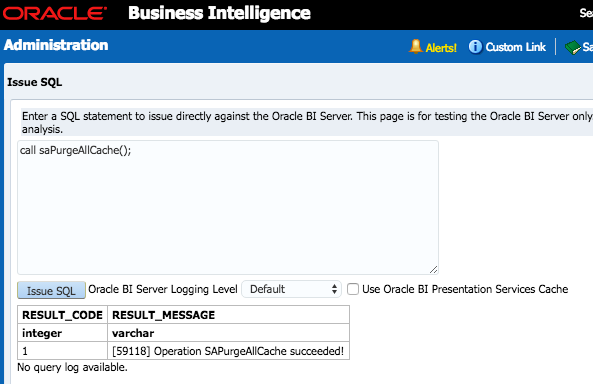
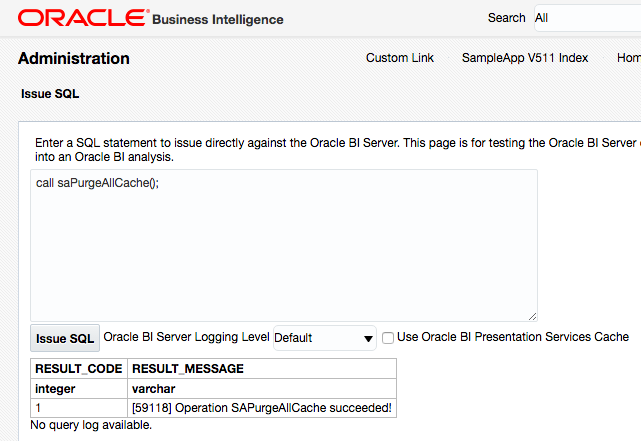
Then I can use another BI Server procedure call to view the current cache contents (new in 11.1.1.9), call NQS_GetAllCacheEntries(). For this one particularly make sure you've un-ticked "Use Oracle BI Presentation Services Cache". This is different from the BI Server cache which is the subject of this article, and as the name implies is a cache that Presentation Services keeps.
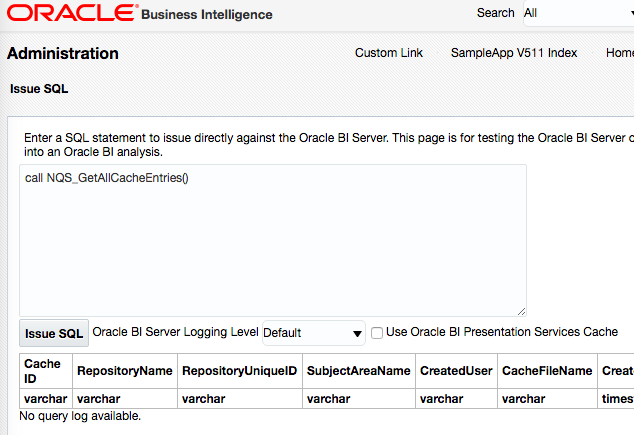
I've confirmed that the BI Server cache is enabled on both servers, in NQSConfig.INI
###############################################################################
#
# Query Result Cache Section
#
###############################################################################
[CACHE]
ENABLE = YES; # This Configuration setting is managed by Oracle Enterprise Manager Fusion Middleware Control
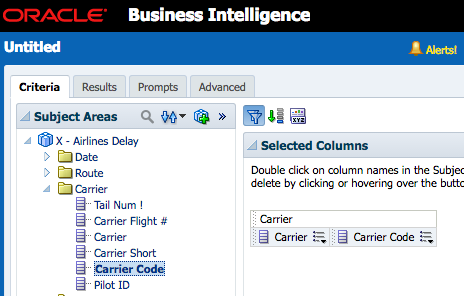 After clicking Results, a cache entry is inserted on each respective system:
After clicking Results, a cache entry is inserted on each respective system:
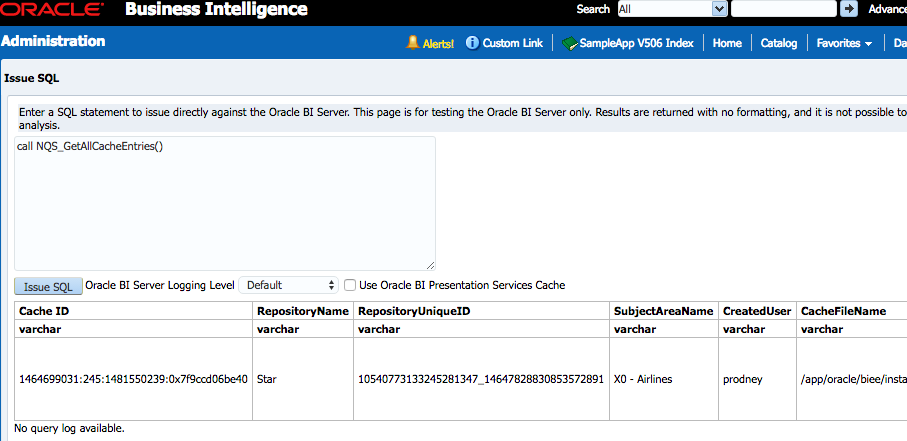
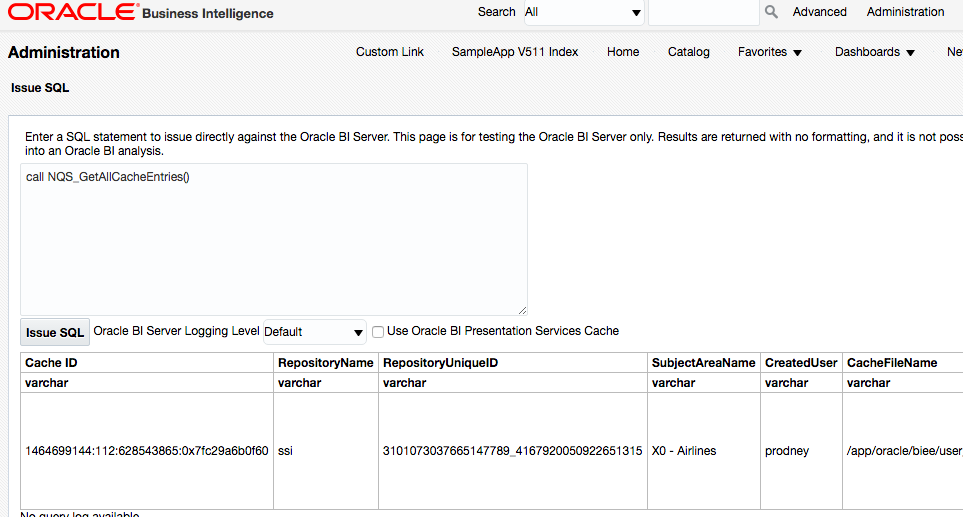 Of particular interest is the create time, last used time, and number of times used:
Of particular interest is the create time, last used time, and number of times used:
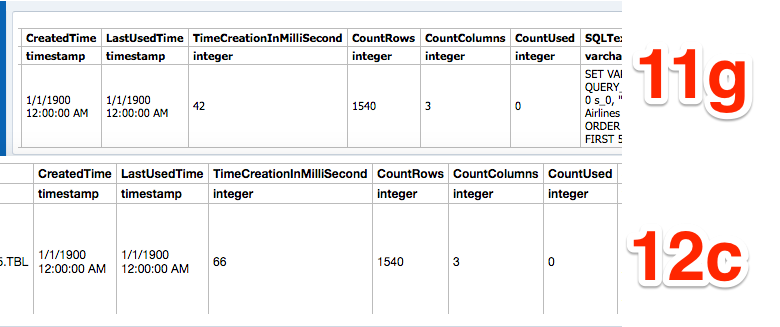 If I now click Refresh in the Analysis window:
If I now click Refresh in the Analysis window:
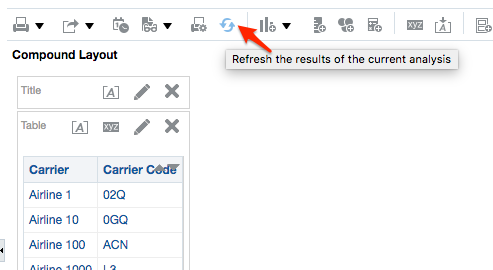 We see this happen to the caches:
We see this happen to the caches:
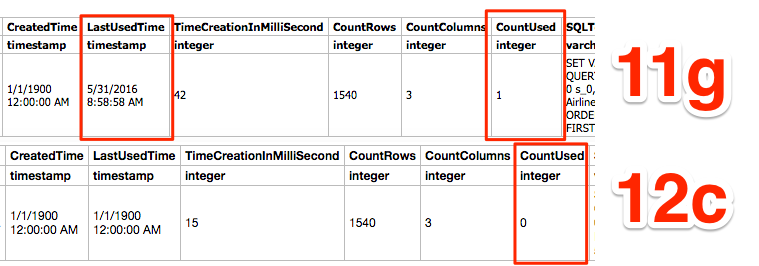 In OBIEE 11g the cache entry is used - but in OBIEE 12c it's not. The
In OBIEE 11g the cache entry is used - but in OBIEE 12c it's not. The CreatedTime is evidently not populated correctly, so instead let's dive over to the query log (nqquery/obis1-query in 11g/12c respectively). In OBIEE 11g we've got:
-- SQL Request, logical request hash: 7c365697 SET VARIABLE QUERY_SRC_CD='Report',PREFERRED_CURRENCY='USD';SELECT 0 s_0, "X - Airlines Delay"."Carrier"."Carrier Code" s_1, "X - Airlines Delay"."Carrier"."Carrier" s_2 FROM "X - Airlines Delay" ORDER BY 1, 3 ASC NULLS LAST, 2 ASC NULLS LAST FETCH FIRST 5000001 ROWS ONLY -- Cache Hit on query: [[ Matching Query: SET VARIABLE QUERY_SRC_CD='Report',PREFERRED_CURRENCY='USD';SELECT 0 s_0, "X - Airlines Delay"."Carrier"."Carrier Code" s_1, "X - Airlines Delay"."Carrier"."Carrier" s_2 FROM "X - Airlines Delay" ORDER BY 1, 3 ASC NULLS LAST, 2 ASC NULLS LAST FETCH FIRST 5000001 ROWS ONLYWhereas 12c is:
-- SQL Request, logical request hash:
d53f813c
SET VARIABLE OBIS_REFRESH_CACHE=1,QUERY_SRC_CD='Report',PREFERRED_CURRENCY='USD';SELECT
0 s_0,
"X - Airlines Delay"."Carrier"."Carrier Code" s_1,
"X - Airlines Delay"."Carrier"."Carrier" s_2
FROM "X - Airlines Delay"
ORDER BY 3 ASC NULLS LAST, 2 ASC NULLS LAST
FETCH FIRST 5000001 ROWS ONLY
-- Sending query to database named X0 - Airlines Demo Dbs (ORCL) (id: <<320369>>), connection pool named Aggr Connection, logical request hash d53f813c, physical request hash a46c069c: [[
WITH
SAWITH0 AS (select T243.CODE as c1,
T243.DESCRIPTION as c2
from
BI_AIRLINES.UNIQUE_CARRIERS T243 /* 30 UNIQUE_CARRIERS */ )
select D1.c1 as c1, D1.c2 as c2, D1.c3 as c3 from ( select 0 as c1,
D1.c1 as c2,
D1.c2 as c3
from
SAWITH0 D1
order by c3, c2 ) D1 where rownum <= 5000001
-- Query Result Cache: [59124] The query for user 'prodney' was inserted into the query result cache. The filename is '/app/oracle/biee/user_projects/domains/bi/servers/obis1/cache/NQS__736117_52416_27.TBL'.
Looking closely at the 12c output shows three things:
- OBIEE has run a database query for this request, and not hit the cache
- A cache entry has clearly been created again as a result of this query
- The Logical SQL has a request variable set:
OBIS_REFRESH_CACHE=1This is evidently added it by Presentation Services at runtime, since the Advanced tab of the analysis shows no such variable being set: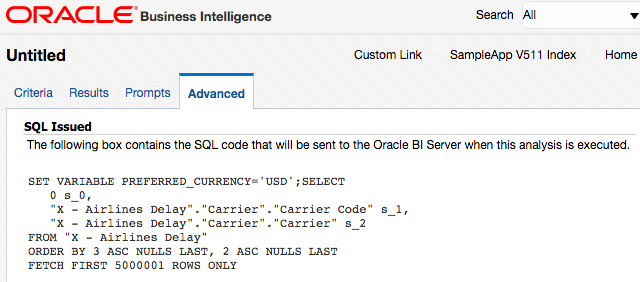
 Nope, no hit.
Nope, no hit.
 But, in the BI Server query log, no entry either - and the same on 11g. The reason being .... Presentation Service's cache. D'oh!
From Administration > Manage Sessions I select Close All Cursors which forces a purge of the Presentation Services cache. When I reopen the analysis from the Catalog view, now I get a cache hit, in both 11g and 12c:
But, in the BI Server query log, no entry either - and the same on 11g. The reason being .... Presentation Service's cache. D'oh!
From Administration > Manage Sessions I select Close All Cursors which forces a purge of the Presentation Services cache. When I reopen the analysis from the Catalog view, now I get a cache hit, in both 11g and 12c:
 The same happens (successful cache hit) for the analysis used in a Dashboard being opened, having purged the Presentation Services cache first.
The same happens (successful cache hit) for the analysis used in a Dashboard being opened, having purged the Presentation Services cache first.
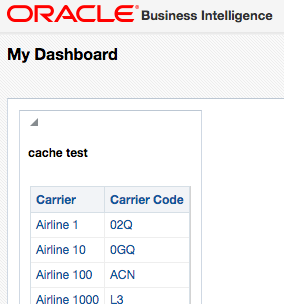 So at this point, we can say that OBIEE 11g and 12c both behave the same with the cache when opening analyses/dashboards, but differ when refreshing the analysis. In OBIEE 12c when an analysis is refreshed the cache is deliberately bypassed. Let's check on refreshing a dashboard:
So at this point, we can say that OBIEE 11g and 12c both behave the same with the cache when opening analyses/dashboards, but differ when refreshing the analysis. In OBIEE 12c when an analysis is refreshed the cache is deliberately bypassed. Let's check on refreshing a dashboard:
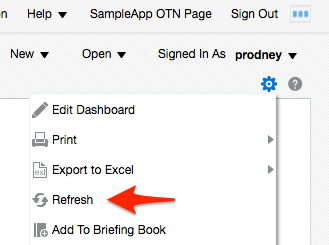 Same behaviour as with analyses - in 11g the cache is hit, in 12c the cache is bypassed and repopulated
Same behaviour as with analyses - in 11g the cache is hit, in 12c the cache is bypassed and repopulated
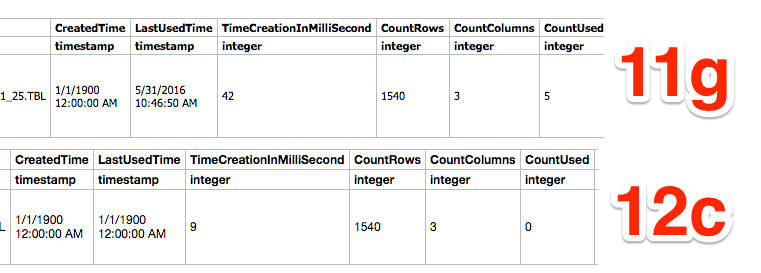 To round this off, let's doublecheck the behaviour of the new request variable that we've found,
To round this off, let's doublecheck the behaviour of the new request variable that we've found, OBIS_REFRESH_CACHE. Since it appears that Presentation Services is adding it in at runtime, let's step over to a more basic way of interfacing with the BI Server - nqcmd. Whilst we could probably use Issue SQL (as we did above for querying the cache) I want to avoid any more behind-the-scenes funny business from Presentation Services.
In OBIEE 12c, I run nqcmd:
/app/oracle/biee/user_projects/domains/bi/bitools/bin/nqcmd.sh -d AnalyticsWeb -u prodney -p Admin123
SET VARIABLE OBIS_REFRESH_CACHE=1,QUERY_SRC_CD='Report',PREFERRED_CURRENCY='USD';SELECT 0 s_0, "X - Airlines Delay"."Carrier"."Carrier Code" s_1, "X - Airlines Delay"."Carrier"."Carrier" s_2 FROM "X - Airlines Delay" ORDER BY 3 ASC NULLS LAST, 2 ASC NULLS LAST FETCH FIRST 5000001 ROWS ONLY
Query Result Cache: [59124] The query for user 'prodney' was inserted into the query result cache. The filename is '/app/oracle/biee/user_projects/domains/bi/servers/obis1/cache/NQS__736117_53779_29.TBL'.
OBIS_REFRESH_CACHE variable:
SET VARIABLE QUERY_SRC_CD='Report',PREFERRED_CURRENCY='USD';SELECT 0 s_0, "X - Airlines Delay"."Carrier"."Carrier Code" s_1, "X - Airlines Delay"."Carrier"."Carrier" s_2 FROM "X - Airlines Delay" ORDER BY 3 ASC NULLS LAST, 2 ASC NULLS LAST FETCH FIRST 5000001 ROWS ONLY
-------------------- Cache Hit on query: [[
Matching Query: SET VARIABLE OBIS_REFRESH_CACHE=1,QUERY_SRC_CD='Report',PREFERRED_CURRENCY='USD';SELECT 0 s_0, "X - Airlines Delay"."Carrier"."Carrier Code" s_1, "X - Airlines Delay"."Carrier"."Carrier" s_2 FROM "X - Airlines Delay" ORDER BY 3 ASC NULLS LAST, 2 ASC NULLS LAST FETCH FIRST 5000001 ROWS ONLY
Created by: prodney
Summary
In OBIEE 12c, if you click "Refresh" on an analysis or dashboard, OBIEE Presentation Services forces a cache-bypass and cache-reseed, ensuring that you really do see the latest version of the data from source. It does this using the request variable, new in OBIEE 12c,OBIS_REFRESH_CACHE.
Footnote
Courtesy of Steve Fitzgerald:As per the presentation server xsd, you can also revert the behavior (not sure why one would, but you can) in the instanceconfig.xml<Cache> <Query> <RefreshIncludeBIServerCache>false</RefreshIncludeBIServerCache> </Query> </Cache>
Changes in BI Server Cache Behaviour in OBIEE 12c : OBIS_REFRESH_CACHE
The OBIEE BI Server cache can be a great way of providing a performance boost to response times for end users – so long as it’s implemented carefully. Done wrong, and you’re papering over the cracks and heading for doom; done right, and it’s the ‘icing on the cake’. You can read more about how to use it properly here, and watch a video I did about it here. In this article we’ll see how the BI Server cache has changed in OBIEE 12c in a way that could prove somewhat perplexing to developers used to OBIEE 11g.
The BI Server cache works by inspecting queries as they are sent to the BI Server, and deciding if an existing cache entry can be used to provide the data. This can include direct hits (i.e. the same query being run again), or more advanced cases, where a subset or aggregation of an existing cache entry could be used. If a cache entry is used then a trip to the database is avoided and response times will typically be better – particularly if more than one database query would have been involved, or lots of additional post-processing on the BI Server.
When an analysis or dashboard is run, Presentation Services generates the necessary Logical SQL to return the data needed, and sends this to the BI Server. It’s at this point that the cache will, or won’t, kick in. The BI Server will accept Logical SQL from other sources than Presentation Services – in fact, any JDBC or ODBC client. This is useful as it enables us to validate behaviour that we’re observing and see how it can apply elsewhere.
When you build an Analysis in OBIEE 11g (and before), the cache will be used if applicable. Each time you add a column, or hit refresh, you’ll get an entry back from the cache if one exists. This has benefits – speed – but disadvantages too. When the data in the database changes, you will still get a cache hit, regardless. The only way to force OBIEE to show you the latest version of the data is to purge the cache first. You can target cache purges based on databases, tables, or even specific queries – but you do need to purge it.
What’s changed in OBIEE 12c is that when you click “Refresh” on an Analysis or Dashboard, the query is re-run against the source and the cache re-populated. Even if you have an existing cache entry, and even if the underlying data has not changed, if you hit Refresh, the cache will not be used. Which kind of makes sense, since “refresh” probably should indeed mean that.
Digging into OBIEE Cache Behaviour
Let’s prove this out. I’ve got SampleApp v506 (OBIEE 11.1.1.9), and SampleApp v511 (OBIEE 12.2.1). First off, I’ll clear the cache on each, using call saPurgeAllCache();, run via Issue SQL:


Then I can use another BI Server procedure call to view the current cache contents (new in 11.1.1.9), call NQS_GetAllCacheEntries(). For this one particularly make sure you’ve un-ticked “Use Oracle BI Presentation Services Cache”. This is different from the BI Server cache which is the subject of this article, and as the name implies is a cache that Presentation Services keeps.

I’ve confirmed that the BI Server cache is enabled on both servers, in NQSConfig.INI
############################################################################### # # Query Result Cache Section # ############################################################################### [CACHE] ENABLE = YES; # This Configuration setting is managed by Oracle Enterprise Manager Fusion Middleware Control
Now I create a very simple analysis in both 11g and 12c, showing a list of Airline Carriers and their Codes:

After clicking Results, a cache entry is inserted on each respective system:


Of particular interest is the create time, last used time, and number of times used:

If I now click Refresh in the Analysis window:

We see this happen to the caches:

In OBIEE 11g the cache entry is used – but in OBIEE 12c it’s not. The CreatedTime is evidently not populated correctly, so instead let’s dive over to the query log (nqquery/obis1-query in 11g/12c respectively). In OBIEE 11g we’ve got:
-- SQL Request, logical request hash: 7c365697 SET VARIABLE QUERY_SRC_CD='Report',PREFERRED_CURRENCY='USD';SELECT 0 s_0, "X - Airlines Delay"."Carrier"."Carrier Code" s_1, "X - Airlines Delay"."Carrier"."Carrier" s_2 FROM "X - Airlines Delay" ORDER BY 1, 3 ASC NULLS LAST, 2 ASC NULLS LAST FETCH FIRST 5000001 ROWS ONLY -- Cache Hit on query: [[ Matching Query: SET VARIABLE QUERY_SRC_CD='Report',PREFERRED_CURRENCY='USD';SELECT 0 s_0, "X - Airlines Delay"."Carrier"."Carrier Code" s_1, "X - Airlines Delay"."Carrier"."Carrier" s_2 FROM "X - Airlines Delay" ORDER BY 1, 3 ASC NULLS LAST, 2 ASC NULLS LAST FETCH FIRST 5000001 ROWS ONLY
Whereas 12c is:
-- SQL Request, logical request hash:
d53f813c
SET VARIABLE OBIS_REFRESH_CACHE=1,QUERY_SRC_CD='Report',PREFERRED_CURRENCY='USD';SELECT
0 s_0,
"X - Airlines Delay"."Carrier"."Carrier Code" s_1,
"X - Airlines Delay"."Carrier"."Carrier" s_2
FROM "X - Airlines Delay"
ORDER BY 3 ASC NULLS LAST, 2 ASC NULLS LAST
FETCH FIRST 5000001 ROWS ONLY
-- Sending query to database named X0 - Airlines Demo Dbs (ORCL) (id: <<320369>>), connection pool named Aggr Connection, logical request hash d53f813c, physical request hash a46c069c: [[
WITH
SAWITH0 AS (select T243.CODE as c1,
T243.DESCRIPTION as c2
from
BI_AIRLINES.UNIQUE_CARRIERS T243 /* 30 UNIQUE_CARRIERS */ )
select D1.c1 as c1, D1.c2 as c2, D1.c3 as c3 from ( select 0 as c1,
D1.c1 as c2,
D1.c2 as c3
from
SAWITH0 D1
order by c3, c2 ) D1 where rownum <= 5000001
-- Query Result Cache: [59124] The query for user 'prodney' was inserted into the query result cache. The filename is '/app/oracle/biee/user_projects/domains/bi/servers/obis1/cache/NQS__736117_52416_27.TBL'.
Looking closely at the 12c output shows three things:
- OBIEE has run a database query for this request, and not hit the cache
- A cache entry has clearly been created again as a result of this query
- The Logical SQL has a request variable set:
OBIS_REFRESH_CACHE=1This is evidently added it by Presentation Services at runtime, since the Advanced tab of the analysis shows no such variable being set:

Let’s save the analysis, and experiment further. Evidently, the cache is being deliberately bypassed when the Refresh button is clicked when building an analysis – but what about when it is opened from the Catalog? We should see a cache hit here too:

Nope, no hit.

But, in the BI Server query log, no entry either – and the same on 11g. The reason being …. Presentation Service’s cache. D’oh!
From Administration > Manage Sessions I select Close All Cursors which forces a purge of the Presentation Services cache. When I reopen the analysis from the Catalog view, now I get a cache hit, in both 11g and 12c:

The same happens (successful cache hit) for the analysis used in a Dashboard being opened, having purged the Presentation Services cache first.

So at this point, we can say that OBIEE 11g and 12c both behave the same with the cache when opening analyses/dashboards, but differ when refreshing the analysis. In OBIEE 12c when an analysis is refreshed the cache is deliberately bypassed. Let’s check on refreshing a dashboard:

Same behaviour as with analyses – in 11g the cache is hit, in 12c the cache is bypassed and repopulated

To round this off, let’s doublecheck the behaviour of the new request variable that we’ve found, OBIS_REFRESH_CACHE. Since it appears that Presentation Services is adding it in at runtime, let’s step over to a more basic way of interfacing with the BI Server – nqcmd. Whilst we could probably use Issue SQL (as we did above for querying the cache) I want to avoid any more behind-the-scenes funny business from Presentation Services.
In OBIEE 12c, I run nqcmd:
/app/oracle/biee/user_projects/domains/bi/bitools/bin/nqcmd.sh -d AnalyticsWeb -u prodney -p Admin123
Enter Q to enter a query, as follows:
SET VARIABLE OBIS_REFRESH_CACHE=1,QUERY_SRC_CD='Report',PREFERRED_CURRENCY='USD';SELECT 0 s_0, "X - Airlines Delay"."Carrier"."Carrier Code" s_1, "X - Airlines Delay"."Carrier"."Carrier" s_2 FROM "X - Airlines Delay" ORDER BY 3 ASC NULLS LAST, 2 ASC NULLS LAST FETCH FIRST 5000001 ROWS ONLY
In `obis1-query.log’ there’s the cache bypass and populate:
Query Result Cache: [59124] The query for user 'prodney' was inserted into the query result cache. The filename is '/app/oracle/biee/user_projects/domains/bi/servers/obis1/cache/NQS__736117_53779_29.TBL'.
If I run it again without the OBIS_REFRESH_CACHE variable:
SET VARIABLE QUERY_SRC_CD='Report',PREFERRED_CURRENCY='USD';SELECT 0 s_0, "X - Airlines Delay"."Carrier"."Carrier Code" s_1, "X - Airlines Delay"."Carrier"."Carrier" s_2 FROM "X - Airlines Delay" ORDER BY 3 ASC NULLS LAST, 2 ASC NULLS LAST FETCH FIRST 5000001 ROWS ONLY
We get the cache hit as expected:
-------------------- Cache Hit on query: [[ Matching Query: SET VARIABLE OBIS_REFRESH_CACHE=1,QUERY_SRC_CD='Report',PREFERRED_CURRENCY='USD';SELECT 0 s_0, "X - Airlines Delay"."Carrier"."Carrier Code" s_1, "X - Airlines Delay"."Carrier"."Carrier" s_2 FROM "X - Airlines Delay" ORDER BY 3 ASC NULLS LAST, 2 ASC NULLS LAST FETCH FIRST 5000001 ROWS ONLY Created by: prodney
Out of interest I ran the same two tests on 11g — both resulted in a cache hit, since it presumably ignores the unrecognised variable.
Summary
In OBIEE 12c, if you click “Refresh” on an analysis or dashboard, OBIEE Presentation Services forces a cache-bypass and cache-reseed, ensuring that you really do see the latest version of the data from source. It does this using the request variable, new in OBIEE 12c, OBIS_REFRESH_CACHE.
The post Changes in BI Server Cache Behaviour in OBIEE 12c : OBIS_REFRESH_CACHE appeared first on Rittman Mead Consulting.
Under the Covers of OBIEE 12c Configuration with sysdig
OBIEE 12c has changed quite a lot in how it manages configuration. In OBIEE 11g configuration was based around system MBeans and the biee-domain.xml as the master copy of settings - and if you updated a configuration directly that was centrally managed, it would get reverted back. Now in OBIEE 12c configuration can be managed directly in text files again - but also through EM still (not to mention WLST). Confused? Yep, I was.
In the configuration files such as NQSConfig.INI there are settings still marked with the ominous comment:
# This Configuration setting is managed by Oracle Enterprise Manager Fusion Middleware Control
In 11g this meant - dragons be here; turn back all ye who don't want to have your configuration settings wiped next time the stack boots.
Now in 12c, I can make a configuration change (such as enabling BI Server caching), restart the affected component, and the change will take affect -- and persist through a restart of the whole OBIEE stack. All good.

But ... the fly in the ointment. If I restart just the affected component (for example, BI Server for an NQSConfig.INI change), since I don't want to waste time bouncing the whole stack if I don't need to, then Enterprise Manager will continue to show the old setting:
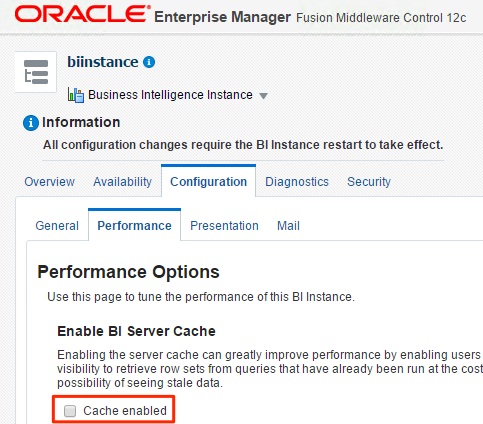
So even though in fact the cache is enabled (and I can see entries being populated in it), Enterprise Manager suggests that it's not. Confusing.
So ... if we're going to edit configuration files by hand (and personally I prefer to, since it saves firing up a web browser), we need to know how to make sure Enterprise Manager will to reflect the change too. Does EM poll the file whilst running? Or something direct to each component to request the configuration? Or maybe it just reads the file on startup only?
Enter sysdig! What I'm about to use it for is pretty darn trivial (and could probably be done with other standard *nix tools), but is still a useful example. What we want to know is which process reads NQSConfig.INI, and from there isolate the particular component that we need to restart to get it to trigger a re-read of the file and thus correctly show the value in Enterprise Manager.
I ran sysdig with a filter for filename and custom output format to include the process PID:
sudo sysdig -A -p "%evt.num %evt.time %evt.cpu %proc.name (%proc.pid) %evt.dir %evt.info" "fd.filename=NQSConfig.INI and evt.type=open"
Nothing was written (i.e. nothing was polling the file), until I bounced the full OBIEE stack ($DOMAINHOME/bitools/bin/stop.sh && $DOMAINHOME/bitools/bin/start.sh). During the startup of the AdminServer, sysdig showed:
32222110 12:00:49.912132008 3 java (10409) < fd=874(/app/oracle/biee/user_projects/domains/bi/config/fmwconfig/biconfig/OBIS/NQSConfig.INI) name=/app/oracle/biee/user_projects/domains/bi/config/fmwconfig/biconfig/OBIS/NQSConfig.INI flags=1(O_RDONLY) mode=0
So - it's the java process that reads it, PID 10409. Which is that?
$ ps -ef|grep 10409
oracle 10409 10358 99 11:59 ? 00:03:54 /usr/java/jdk1.8.0_51/bin/java -server -Xms512m -Xmx1024m -Dweblogic.Name=AdminServer [...]
It's AdminServer -- which makes sense, because Enterprise Manager is a java deployment hosted in AdminServer.
So, if you want to hack the config files by hand, restart either the whole OBIEE stack, or the affected component plus AdminServer in order for Enterprise Manager to pick up the change.
Under the Covers of OBIEE 12c Configuration with sysdig
OBIEE 12c has changed quite a lot in how it manages configuration. In OBIEE 11g configuration was based around system MBeans and the biee-domain.xml as the master copy of settings – and if you updated a configuration directly that was centrally managed, it would get reverted back. Now in OBIEE 12c configuration can be managed directly in text files again – but also through EM still (not to mention WLST). Confused? Yep, I was.
In the configuration files such as NQSConfig.INI there are settings still marked with the ominous comment:
# This Configuration setting is managed by Oracle Enterprise Manager Fusion Middleware Control
In 11g this meant – dragons be here; turn back all ye who don’t want to have your configuration settings wiped next time the stack boots.
Now in 12c, I can make a configuration change (such as enabling BI Server caching), restart the affected component, and the change will take affect — and persist through a restart of the whole OBIEE stack. All good.

But … the fly in the ointment. If I restart just the affected component (for example, BI Server for an NQSConfig.INI change), since I don’t want to waste time bouncing the whole stack if I don’t need to, then Enterprise Manager will continue to show the old setting:

So even though in fact the cache is enabled (and I can see entries being populated in it), Enterprise Manager suggests that it’s not. Confusing.
So … if we’re going to edit configuration files by hand (and personally I prefer to, since it saves firing up a web browser), we need to know how to make sure Enterprise Manager will to reflect the change too. Does EM poll the file whilst running? Or something direct to each component to request the configuration? Or maybe it just reads the file on startup only?
Enter sysdig! What I’m about to use it for is pretty darn trivial (and could probably be done with other standard *nix tools), but is still a useful example. What we want to know is which process reads NQSConfig.INI, and from there isolate the particular component that we need to restart to get it to trigger a re-read of the file and thus correctly show the value in Enterprise Manager.
I ran sysdig with a filter for filename and custom output format to include the process PID:
sudo sysdig -A -p "%evt.num %evt.time %evt.cpu %proc.name (%proc.pid) %evt.dir %evt.info" "fd.filename=NQSConfig.INI and evt.type=open"
Nothing was written (i.e. nothing was polling the file), until I bounced the full OBIEE stack ($DOMAIN_HOME/bitools/bin/stop.sh && $DOMAIN_HOME/bitools/bin/start.sh). During the startup of the AdminServer, sysdig showed:
32222110 12:00:49.912132008 3 java (10409) < fd=874(<f>/app/oracle/biee/user_projects/domains/bi/config/fmwconfig/biconfig/OBIS/NQSConfig.INI) name=/app/oracle/biee/user_projects/domains/bi/config/fmwconfig/biconfig/OBIS/NQSConfig.INI flags=1(O_RDONLY) mode=0
So – it’s the java process that reads it, PID 10409. Which is that?
$ ps -ef|grep 10409 oracle 10409 10358 99 11:59 ? 00:03:54 /usr/java/jdk1.8.0_51/bin/java -server -Xms512m -Xmx1024m -Dweblogic.Name=AdminServer [...]
It’s AdminServer — which makes sense, because Enterprise Manager is a java deployment hosted in AdminServer.
So, if you want to hack the config files by hand, restart either the whole OBIEE stack, or the affected component plus AdminServer in order for Enterprise Manager to pick up the change.
The post Under the Covers of OBIEE 12c Configuration with sysdig appeared first on Rittman Mead Consulting.
Contemplating Upgrading to OBIEE 12c?
Where You Are Now

OBIEE 12c has been out for some time, and it seems like most folks are delaying upgrading to OBIEE 12c until the very last minute. Or at least until Oracle decides to put out another major version change of OBIEE, which is understandable. You’ve already spent time and money and devoted hundreds of resource hours to system monitoring, maintenance, testing, and development. Maybe you’ve invested in staff training to try to maximize your ROI in your existing OBIEE purchase. And now, after all this time and effort, you and your team have finally gotten things just right. Your BI engine is humming along, user adoption and stickiness are up, and you don’t have a lot of dead objects clogging up the Web Catalog. Your report hacks and work-arounds have been worked and reworked to become sustainable and maintainable business solutions. Everyone is getting what they want.
Sure, this scenario is part fantasy, but it doesn’t mean that as a BI team lead or member, you’re not always working toward this end. It would be nice to think that the people designing the tools with which we do this work understood the daily challenges and processes we must undergo in order to maintain the precarious homeostasis of our BI ecosystems. That’s where Rittman Mead comes in. If you’re considering upgrading to OBIEE 12c, or are even curious, keep reading. We’re here to help.
So Why Upgrade
Let’s get right down to it. Shoot over here and here to check out what our very own Mark Rittman had to say about the good, the bad, and the ugly of 12c. Our Silvia Rauton did a piece on lots of the nuts and bolts of 12c’s new front-end features. They’re all worth a read. Upgrading to OBIEE 12c offers many exciting new features that shouldn’t be ignored.

How Rittman Mead Can Help
We understand what it is to be presented with so many project challenges. Do you really want to risk the potential perils and pitfalls presented by upgrading to OBIEE 12c? We work both harder and smarter to make this stuff look good. And we get the most out of strategy and delivery via a number of in-house tools designed to keep your OBIEE deployment in tip top shape.
Maybe you want to make sure all your Catalog and RPD content gets ported over without issue? Instead of spending hours on testing every dashboard, report, and other catalog content post-migration, we’ve got the Automated Regression Testing package in our tool belt. We deploy this series of proprietary scripts and dashboards to ensure that everything will work just the way it was, if not better, from one version to the next.
Maybe you’d like to make sure your system will fire on all cylinders or you’d like to proactively monitor your OBIEE implementation. For that we’ve got the Performance Analytics Dashboards, built on the open source ELK stack to give you live, active monitoring of critical BI system stats and the underlying database and OS.

On top of these tools, we’ve got the strategies and processes in place to not only guarantee the success of your upgrade, but to ensure that you and your team remain active and involved in the process.
What to Expect
You might be wondering what kinds of issues you can expect to experience during upgrading to OBIEE 12c (which is to say, nothing’s going to break, right?). Are you going to have to go through a big training curve? Does upgrading to OBIEE 12c mean you’re going to experience considerable resource downtime as your team, or an even an outside company, manages this process? To answer this question, I’m reminded of a quote from the movie Fight Club: “Choose your level of involvement.”
While we always prefer to work alongside your BI or IT team to facilitate the upgrade process, we also know that resource time is valuable and that your crew can’t stop what they’re doing until things wraps up. We often find that the more clients are engaged with the process, however, the easier the hand-off is because clients better understand best practices, and IT and BI teams are more empowered for the future.
Learning More about OBIEE 12c
But if you’re like many organizations, maybe you have to stay more hands off and get training after the upgrade is complete. Check out the link here to look over the agenda of our OBIEE 12c Bootcamp training course. Like our hugely popular 11g course, this program is five days of back-to-front instruction taught via a selection of seminars and hands-on labs, designed to impart most everything your team will need to know to continue or begin their successful BI practice.
What we often find is that, in addition to being a thorough and informative course, the Bootcamp is a great way to bring together teams or team members, often dispersed among different offices, under one roof to gain common understanding about how each person plays an important role as a member of the BI process. Whether they handle the ETL, data modeling, or report development, everyone can benefit from what often evolves from a training session into some impromptu team building.
Feel Empowered
If you’re still on the fence about whether or not to upgrade, as I said before, you’re not alone. There are lots of things you need to consider, and rightfully so. You might be thinking, “What does this mean for extra work on the plates of my resources? How can I ensure the success of my project? Is it worth it to do it now, or should I wait for the next release?” Whatever you may be mulling over, we’ve been there, know how to answer the questions, and have some neat tools in our utility belt to move the process along. In the end, I hope to have presented you with some bits to aid you in making a decision about upgrading to OBIEE 12c, or at least the impetus to start thinking about it.
If you’d like any more information or just want to talk more about the ins and outs of what an upgrade might entail, send over an email or give us a call.
The post Contemplating Upgrading to OBIEE 12c? appeared first on Rittman Mead Consulting.


